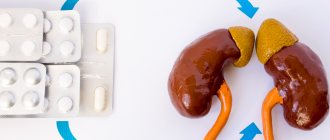Analogues of the drug according to ATC codes:
VICTOEL KETILEPT LAQUEL NANTARIDE SEROCQUEL SEROCQUEL PROLONG
You should consult your doctor before using QUENTIAX. These instructions for use are for informational purposes only. For more complete information, please refer to the manufacturer's instructions.
Release form, composition and packaging
Tablets, film-coated, brownish-red, round, biconvex, chamfered.
| 1 tab. | |
| quetiapine fumarate | 28.78 mg, |
| which corresponds to the content of quetiapine | 25 mg |
Excipients: lactose monohydrate, calcium hydrogen phosphate dihydrate, microcrystalline cellulose, povidone, sodium carboxymethyl starch (type A), magnesium stearate.
Shell composition: hypromellose, titanium dioxide (E171), macrogol 4000, yellow iron oxide dye (E172), red iron oxide dye (E172).
10 pieces. - blisters (3) - cardboard packs. 10 pcs. - blisters (6) - cardboard packs. 10 pcs. - blisters (9) - cardboard packs.
pharmachologic effect
Antipsychotic drug (neuroleptic). Quetiapine is an atypical antipsychotic drug that exhibits a higher affinity for serotonin 5HT2 receptors than for dopamine D1 and D2 receptors in the brain. Quetiapine has an affinity for histamine and α1-adrenergic receptors, and less affinity for α2-adrenergic receptors. No significant affinity of quetiapine for cholinergic muscarinic and benzodiazepine receptors was found.
In standard tests, quetiapine exhibits antipsychotic activity.
The results of a study of extrapyramidal symptoms in animals revealed that quetiapine causes mild catalepsy at a dose that effectively blocks dopamine D2 receptors. Quetiapine causes a selective decrease in the activity of mesolimbic A10-dopaminergic neurons, in comparison with A9-nigrostriatal neurons involved in motor functions.
There were no differences between the use of quetiapine (at a dose of 75-750 mg/day) and placebo in the incidence of extrapyramidal symptoms and in the concomitant use of anticholinergic drugs. Does not cause a long-term increase in the concentration of prolactin in the blood plasma.
Quetiapine maintains long-term clinical improvement in those patients who develop a positive effect at the very beginning of treatment.
The duration of action of quetiapine on serotonin 5HT2 receptors and dopamine and D2 receptors is less than 12 hours after taking the drug.
Pharmacological properties
Pharmacodynamics
The active component of Quentiax, quetiapine, is an atypical antipsychotic drug that exhibits a higher affinity for serotonin 5-HT2 receptors than for dopamine D1 and D2 receptors in the brain. Quetiapine has an affinity for α1- and histamine receptors, and to a lesser extent affinity for α2-receptors. No significant affinity of quetiapine for muscarinic, cholinergic and benzodiazepine receptors was detected. According to the results of standard tests, the manifestation of antipsychotic activity of quetiapine is noted.
As a result of studying EPS (extrapyramidal symptoms) in animals, it was revealed that quetiapine is capable of causing mild catalepsy in doses that effectively block dopamine D2 receptors. It also selectively inhibits the activity of mesolimbic A10-dopaminergic neurons compared to A9-nigrostriatal neurons, which are involved in motor functions.
There were no differences in the incidence of extrapyramidal symptoms and concomitant use of anticholinergic drugs when using therapeutic doses of quetiapine (75–750 mg/day) and placebo.
Quentiax does not cause a prolonged increase in plasma prolactin concentrations.
Quetiapine is able to maintain clinical improvement for a long time, mainly in those patients in whom a positive effect developed from the very beginning of therapy.
The effect of quetiapine on serotonin 5-HT2 and dopamine D2 receptors after taking Quentiax is less than 12 hours.
Pharmacokinetics
The pharmacokinetics of quetiapine does not differ between women and men and is dose-dependent and linear.
Main pharmacokinetic parameters:
- absorption: quetiapine has high absorption; food intake does not affect the bioavailability of the substance;
- distribution: 83% of the drug binds to plasma proteins;
- metabolism: quetiapine, which is actively metabolized in the liver, forms pharmacologically inactive metabolites under the influence of cytochrome P450 (CYP3A4 isoenzyme). Quetiapine and its individual metabolites weakly inhibit cytochrome P450 isoenzymes (1A2, 2C9, 2C19, 2D6 and 3A4), and only in concentrations exceeding at least 10–50 times their content when used in the therapeutic dose range of 300–450 mg per day. day. Based on the results of in vitro studies, it can be assumed that the administration of quetiapine with other drugs will not cause clinically significant inhibition of the metabolism of other substances mediated by the cytochrome P450 system;
- Excretion: Quetiapine is excreted mainly by the kidneys (73%) and intestines (21%). Less than 5% of the substance is not metabolized and is excreted unchanged. T1/2 (half-life) is ~ 7 hours. Average clearance of quetiapine: elderly patients – 30–50% lower than in the age group 18–65 years; patients with severe renal failure with creatinine clearance <30 ml/min/1.73 m2 and patients with liver damage (stable alcoholic cirrhosis) - a decrease of approximately 25%.
Pharmacokinetics
Suction and distribution
Absorption is high, food intake does not affect bioavailability. Plasma protein binding - 83%.
The pharmacokinetics of quetiapine is linear and does not differ between men and women.
Metabolism
Actively metabolized in the liver with the formation of pharmacologically inactive metabolites under the influence of the CYP3A4 isoenzyme. Quetiapine and some of its metabolites are weak inhibitors of human cytochrome P450 isoenzymes 1A2, 2C9, 2C19, 2D6 and 3A4, but only in concentrations at least 10-50 times higher than the drug concentration when used in the effective dose range from 300 to 450 mg/day. days
Based on in vitro results, coadministration of quetiapine with other drugs should not be expected to result in clinically significant inhibition of cytochrome P450-mediated metabolism of other drugs.
Removal
T1/2 is approximately 7 hours. Approximately 73% is excreted by the kidneys and 21% through the intestines. Less than 5% of quetiapine is not metabolized and is excreted unchanged.
Pharmacokinetics in special clinical situations
The average clearance of quetiapine in elderly patients is 30-50% less than in patients aged 18 to 65 years.
Average plasma clearance of quetiapine in patients with severe renal failure (SKR)
Pharmacodynamics and pharmacokinetics
Quentiax tablets are classified as atypical antipsychotics similar to serotonin . The drug also shows affinity for histamine and alpha-1 receptors and slightly with alpha-2 receptors.
The use of these tablets in the prescribed dosage does not cause extrapyramidal symptoms and does not lead to a long-term increase in the concentration of prolactin in the blood plasma .
The positive therapeutic effect, observed from the very beginning of taking the tablets, is maintained for a long time. Their effect on serotonin and dopamine receptors lasts more than 12 hours.
This drug is characterized by high absorption, while its bioavailability does not depend on food intake. Plasma protein binding reaches about 83%. In the body, the drug undergoes active metabolism in the liver. As a result, pharmacologically inactive metabolites . The drug is excreted in several stages in metabolites and unchanged form through the kidneys and intestines.
QUENTIAX: DOSAGE
The drug is prescribed orally, 2 times a day, regardless of meals.
In the treatment of acute and chronic psychoses, including schizophrenia, the daily dose in the first 4 days is: 1st day - 50 mg; 2nd day - 200 mg; 3rd day - 200 mg and 4th day - 300 mg. Starting from the 4th day, the daily dose is 300 mg. Depending on the clinical effect and tolerability of the drug, its dose can vary individually from 150 mg/day to 750 mg/day. The maximum daily dose for the treatment of schizophrenia is 750 mg.
In the treatment of manic episodes in bipolar disorder, quetiapine is recommended as monotherapy or as adjuvant therapy to stabilize mood.
The daily dose in the first 4 days is: 1st day - 100 mg; 2nd day - 200 mg; 3rd day - 300 mg and 4th day - 400 mg. The daily dose can be increased in the future by 200 mg/day and by the 6th day of therapy it is 800 mg. Depending on the clinical effect and tolerability of the drug, its dose can vary individually from 200 mg/day to 800 mg/day. Typically, the effective dose is from 400 mg to 800 mg/day. The maximum daily dose is 800 mg.
Because Plasma clearance of quetiapine in elderly patients is reduced by 30-50%; the drug should be prescribed with caution, especially at the beginning of therapy. The starting dose is 25 mg/day, followed by an increase by 25-50 mg until an effective dose is achieved.
In patients with renal and hepatic insufficiency, it is recommended to start therapy with 25 mg/day. In the future, it is recommended to increase the dose daily by 25-50 mg until an effective dose is achieved.
Reviews of Quentiax
Numerous reviews of Quentiax are found on medical forums, the topics of which are related to various mental disorders. This drug is especially often prescribed to patients suffering from panic attacks. According to users, the effectiveness of the treatment is evident in almost all cases. As a result, fears disappear completely, but many patients experience drowsiness throughout treatment, which can be very undesirable.
An important condition for effective treatment is that this drug should be prescribed only by specialists. The fact is that the therapeutic regimen, and especially its dosage, requires a certain approach, with a gradual increase and then decrease in dose. When a therapeutic effect is achieved, a maintenance dosage of Quentiax 100 mg may be prescribed. Usually this is enough to consolidate the therapeutic effect.
You can also find reports of the development of undesirable effects manifested by extrapyramidal disorders, increased appetite, weight gain and headaches. One way or another, compared to other analogues, the use of this medicine is accompanied by fewer side effects.
Experts note that taking this drug without a prescription is not recommended. Although, as reviews show, none of the patients started taking it on their own. Moreover, these tablets are often prescribed during inpatient treatment. In any case, doctors warn patients against taking this medication on their own, as well as deviating from the therapeutic regimen. This can lead to disruption of the body’s internal regulation, as well as to an even greater deterioration of the mental state.
Overdose
Data on overdose of quetiapine are limited. Cases of taking quetiapine in doses exceeding 30 g have been described. Most patients did not experience side effects, but in cases where they did develop, side effects went away on their own. A case of death has been reported when taking 13.6 g of quetiapine. Cases of quetiapine overdose resulting in QT prolongation, coma, or death have been reported extremely rarely. In patients with a history of severe cardiovascular disease, the risk of side effects from overdose may increase.
Symptoms: excessive sedation, drowsiness, tachycardia, decreased blood pressure.
Treatment: symptomatic therapy is carried out, measures aimed at maintaining respiratory function, the cardiovascular system, adequate oxygenation and ventilation. There are no specific antidotes.
Drug interactions
Quetiapine does not induce liver enzyme systems involved in the metabolism of phenazone and lithium.
Co-administration of quetiapine with drugs that potentially inhibit liver enzymes, such as carbamazepine or phenytoin, as well as barbiturates, rifampicin, may reduce plasma concentrations of quetiapine, which may require an increase in the dose of Quentiax, depending on the clinical effect. This must also be taken into account when discontinuing phenytoin or carbamazepine, or another inducer of the liver enzyme system, or replacing it with a drug that does not induce microsomal liver enzymes (for example, valproic acid).
The main enzyme responsible for the metabolism of quetiapine is the CYP3A4 isoenzyme. The pharmacokinetics of quetiapine is not altered by concomitant use of cimetidine (P450 inhibitor), fluoxetine (CYP3A4 and CYP2D6 inhibitor) or the antidepressant imipramine (CYP2D6 inhibitor).
It is recommended to be careful when using quetiapine simultaneously and systemically using CYP3A4 inhibitors (azole antifungals and macrolide antibiotics), because Plasma concentrations of quetiapine may increase. Therefore, lower doses of quetiapine should be used. Particular attention should be paid to elderly and debilitated patients.
The pharmacokinetics of quetiapine did not change significantly when administered simultaneously with antipsychotics - risperidone or haloperidol. However, simultaneous administration of quetiapine with thioridazine resulted in increased clearance of quetiapine.
CNS depressants and ethanol increase the risk of side effects.
Quentiax price, where to buy
The price of Quentiax tablets varies between 1,700-4,200 rubles. You can buy Quentiax in almost any Russian pharmacy with a prescription.
- Online pharmacies in RussiaRussia
ZdravCity
- Quentiax tablets p.p.o.
200 mg 60 pcs. Krka-Rus LLC 2552 rub. order - Quentiax tablets p.p.o. 300 mg 60 pcs. Krka-Rus LLC
RUB 2881 order
- Quentiax tablets p.p.o. 100 mg 60 pcs. Krka-Rus LLC
RUB 1,175 order
- Quentiax tablets p.p.o. 25 mg 60 pcs. Krka-Rus LLC
RUR 466 order
- Quentiax SR tablets p.p.o. prolonged action 300 mg 60 pcs. JSC KRKA, d.d., Novo mesto
RUB 1,761 order
QUENTIAX: SIDE EFFECTS
Classification of the incidence of side effects (WHO): very often (>1/10), often (>1/100, 1/1000, 1/10,000,
From the hematopoietic system: often - leukopenia; uncommon - eosinophilia; very rarely - neutropenia.
From the central and peripheral nervous system: very often - dizziness, drowsiness, headache; often - syncope; uncommon - anxiety, agitation, insomnia, akathisia, tremor, convulsions, depression, paresthesia; rarely - malignant neuroleptic syndrome (hyperthermia, impaired consciousness, muscle rigidity, vegetative-vascular disorders, increased concentrations of CPK); very rarely - tardive dyskinesia.
From the cardiovascular system: often - tachycardia, orthostatic arterial hypotension, prolongation of the QT interval on the ECG.
From the respiratory system: rhinitis, pharyngitis.
From the digestive system: often - dry mouth, constipation, diarrhea, dyspepsia, increased levels of serum transaminases (AST or ALT); rarely - jaundice, nausea, vomiting, abdominal pain; very rarely - hepatitis.
Allergic reactions: uncommon - skin rash, hypersensitivity reactions; very rarely - angioedema, Stevens-Johnson syndrome.
From the reproductive system: rarely - priapism.
From the endocrine system: often - increase in body weight (mainly in the first weeks of treatment); very rarely - hyperglycemia or decompensation of diabetes mellitus.
Laboratory indicators: infrequently - increased serum GGT levels and triglyceride levels (not on an empty stomach), hypercholesterolemia; decrease in the level of thyroid hormones (total T4 and free T4 /in the first 4 weeks/, as well as total T3 and reverse T3 /only when taking high doses of quetiapine).
Other: often - peripheral edema, asthenia; rarely - lower back pain, chest pain, low-grade fever, myalgia, dry skin, blurred vision.
Side effects
When treated with Quentiax, side effects may occur that affect the functioning of the nervous, respiratory, lymphatic and cardiovascular systems, hematopoietic organs, gastrointestinal tract, and so on.
Therefore, it is possible to develop unfavorable symptoms such as: leukopenia , eosinophilia, metabolic disorders leading to weight gain, dizziness, headache, drowsiness, syncope, tachycardia , arterial hypotension, rhinitis , pharyngitis, dry mouth, diarrhea, constipation, dyspepsia, allergic reactions, swelling, asthenia and so on.
Contraindications
- breastfeeding period;
- children and adolescents under 18 years of age (efficacy and safety have not been established);
- hypersensitivity to quetiapine or other components of the drug.
The drug should be prescribed with caution to patients with cardiovascular and cerebrovascular diseases or other conditions predisposing to arterial hypotension, with congenital increase in the QT interval on the ECG or in the presence of conditions that can potentially cause an increase in the QT interval (simultaneous administration of drugs that prolong the QT interval, congestive heart failure , hypokalemia, hypomagnesemia), with liver failure, epilepsy, history of seizures, pregnancy, elderly patients.
special instructions
With abrupt withdrawal of high doses of antipsychotic drugs, the following acute reactions (withdrawal syndrome) may occur: nausea, vomiting, and rarely insomnia. Cases of exacerbation of psychotic symptoms and the appearance of involuntary movement disorders (akathisia, dystonia, dyskinesia) have been reported. Therefore, it is recommended to discontinue the drug gradually.
When prescribing quetiapine concomitantly with drugs that prolong the QT interval, caution must be exercised, especially in elderly patients with congestive heart failure, hypokalemia and hypomagnesemia.
Given that quetiapine affects the central nervous system, the drug should be used with caution in combination with other drugs that have a depressant effect on the central nervous system. It is recommended to abstain from drinking alcohol.
If symptoms of tardive dyskinesia occur, reduce the dose or discontinue use of quetiapine.
In controlled clinical trials, there was no difference in the incidence of seizures between quetiapine and placebo. However, as with other antipsychotics, caution is recommended when treating patients with a history of seizures.
Neuroleptic malignant syndrome may be associated with antipsychotic treatment. Clinical manifestations of the syndrome include: hyperthermia, altered mental status, muscle rigidity, instability of the autonomic nervous system, increased CPK levels. If this syndrome develops, quetiapine should be discontinued and appropriate treatment administered.
Impact on the ability to drive vehicles and operate machinery
During treatment with quetiapine, it is recommended to be careful when driving vehicles and engaging in other potentially hazardous activities that require increased concentration and speed of psychomotor reactions.
Kventiax® SR (Kventiax® SR)
Children and adolescents (ages 10 to 17 years)
Quentiax® SR is not indicated for use in children and adolescents under 18 years of age due to insufficient data on use in this age group. According to the results of clinical studies, some adverse reactions (increased appetite, increased concentrations of prolactin in the blood serum and EPS) were observed with a higher frequency in children and adolescents than in adult patients. An increase in blood pressure was also noted, which was not observed in adult patients. Changes in thyroid function have also been observed in children and adolescents.
The effects on growth, puberty, mental development and behavioral reactions with long-term use (more than 26 weeks) of quetiapine have not been studied.
In placebo-controlled studies in children and adolescents with schizophrenia and mania in bipolar disorder, the incidence of EPS was higher with quetiapine compared with placebo.
Suicide/suicidal ideation or clinical worsening
Depression is associated with an increased risk of suicidal ideation, self-harm and suicide (suicide-related events). This risk persists until significant remission occurs. Because it may take several weeks or more for the patient's condition to improve from the start of treatment, patients should be under close medical supervision until improvement occurs.
According to generally accepted clinical experience, the risk of suicide may increase in the early stages of remission.
In short-term, placebo-controlled clinical trials in depressed patients with bipolar disorder, the risk of suicide-related events was 3.0% (7/233) for quetiapine and 0% (0/120) for placebo in patients aged 18 years. -24 years, 1.8% (19/1616) for quetiapine and 1.8% (11/622) for placebo in patients aged ≥ 25 years. A population-based retrospective study of quetiapine in patients with major depressive disorder found an increased risk of self-harm and suicide attempts in patients aged 25 to 64 years without a history of self-harm taking quetiapine with other antidepressants.
Other psychiatric disorders treated with quetiapine are also associated with an increased risk of suicide-related events. In addition, such conditions may be comorbid with a depressive episode. Thus, the precautions used when treating patients with a depressive episode should also be taken when treating patients with other mental disorders.
If quetiapine therapy is abruptly discontinued, the potential risk of suicide-related events should be taken into account.
Patients with a history of suicidal events, as well as patients who clearly express suicidal thoughts before starting therapy, are at increased risk of suicidal intent and suicide attempts and should be carefully monitored during treatment.
In patients with manic bipolar disorder, the risk of suicide-related events was 0% (0/60) for quetiapine and 0% (0/58) for placebo in patients aged 18–24 years, 1.2% (6 /496) for quetiapine and 1.2% (6/503) for placebo in patients aged ≥ 25 years, 1.0% (2/193) for quetiapine and 0% (0/90) for placebo in patients aged up to 18 years old.
In patients with schizophrenia, the risk of suicide-related events was 1.4% (3/212) for quetiapine and 1.6% (1/62) for placebo in patients aged 18–24 years, 0.8% ( 13/1663) for quetiapine and 1.1% (5/463) for placebo in patients aged ≥ 25 years, 1.4% (2/147) for quetiapine and 1.3% (1/75) for placebo in patients under the age of 18 years.
In patients with a depressive episode, the risk of suicide-related events was 2.1% (3/144) for quetiapine and 1.3% (1/75) for placebo in patients aged 18–24 years, 0.6% (11/1798) for quetiapine and 0.7% (7/1054) for placebo in patients aged ≥ 25 years. Patients under the age of 18 years did not participate in studies for this indication.
Overall, the rate of suicide events was 0.8% for both quetiapine (76/9327) and placebo (37/4845) across short-term placebo-controlled studies across all indications and all age groups.
Extrapyramidal symptoms
There was an increase in the incidence of EPS when taking quetiapine in adult patients with a major depressive episode in the structure of bipolar disorder or major depressive disorder compared to placebo (see section "Side effects"). However, during quetiapine therapy in patients with schizophrenia and mania in the structure of bipolar disorder, there was no increase in the incidence of EPS compared to placebo.
Tardive dyskinesia
While taking antipsychotics, including quetiapine, tardive dyskinesia may occur, which is manifested by violent involuntary movements and may be irreversible. If symptoms of tardive dyskinesia develop, it is recommended to reduce the dose of the drug or gradually discontinue it. Symptoms of tardive dyskinesia may intensify or even occur after stopping the drug (see section "Side effects").
While taking quetiapine, akathisia may occur, which is characterized by an unpleasant feeling of motor restlessness and the need to move and is manifested by the patient's inability to sit or stand without moving. If such symptoms occur, the dose of quetiapine should not be increased.
Drowsiness and dizziness
During quetiapine therapy, drowsiness and associated symptoms, such as sedation, may occur (see section "Side effects"). In clinical studies involving patients with depression in the structure of bipolar disorder and with a depressive episode, somnolence usually developed during the first three days of therapy. The severity of this adverse reaction was generally minor or moderate. If severe drowsiness develops, patients with depression as part of bipolar disorder and patients with a depressive episode may require more frequent visits to the doctor within 2 weeks from the onset of drowsiness or until the severity of symptoms decreases. In some cases, discontinuation of quetiapine therapy may be necessary.
Orthostatic hypotension and dizziness may occur during quetiapine therapy (see section "Side Effects"), usually during dose titration at the beginning of therapy. Patients, especially older patients, should be careful to avoid accidental injury (falls).
Patients with cardiovascular diseases
Caution should be exercised when using quetiapine in patients with cardiovascular, cerebrovascular disease and other conditions predisposing to arterial hypotension. In such patients, dose selection should be slower. Orthostatic hypotension may occur during quetiapine therapy, especially during dose titration at the beginning of therapy. If orthostatic hypotension occurs, a dose reduction or more gradual titration may be required.
Sleep apnea syndrome
Sleep apnea syndrome has been reported in patients taking quetiapine. Caution should be exercised when prescribing quetiapine to patients receiving drugs that have a depressant effect on the central nervous system, as well as patients with risk factors for sleep apnea (for example, overweight/obesity, male gender) or with a history of sleep apnea.
Seizures
There were no differences in the incidence of seizures in patients taking quetiapine or placebo. However, as with other antipsychotic drugs, caution is recommended when treating patients with a history of seizures (see section "Side effects").
Neuroleptic malignant syndrome
While taking antipsychotic drugs, including quetiapine, neuroleptic malignant syndrome may develop (see section “Side effects”). Clinical manifestations of the syndrome include hyperthermia, altered mental status, muscle rigidity, lability of the autonomic nervous system, and increased creatine phosphokinase activity. In such cases, it is necessary to stop taking quetiapine and carry out appropriate treatment.
Severe neutropenia and agranulocytosis
In short-term, placebo-controlled clinical trials of quetiapine monotherapy, cases of severe neutropenia (neutrophil count <0.5 x 109/L) without infection were reported infrequently. The development of agranulocytosis (severe neutropenia associated with infections) has been reported in patients receiving quetiapine in clinical trials (rare), as well as during post-marketing use (including death). Most of these cases of severe neutropenia occurred several months after initiation of quetiapine therapy. No dose-dependent effect was found. Leukopenia and/or neutropenia resolved after discontinuation of quetiapine therapy. Possible risk factors for the occurrence of neutropenia are a previous low white blood cell count and a history of drug-induced neutropenia.
The development of agranulocytosis was also noted in patients without risk factors. The possibility of neutropenia should be considered in patients with infection, especially in the absence of obvious predisposing factors, or in patients with unexplained fever, and these cases should be managed in accordance with clinical guidelines.
In patients with a neutrophil count <1.0 x 109/L, quetiapine should be discontinued. The patient should be observed for possible symptoms of infection and the neutrophil count should be monitored (until the count rises to 1.5 x 109/L).
Anticholinergic (muscarinic-like) effects
Norquetiapine, the active metabolite of quetiapine, has moderate to strong affinity for several muscarinic receptor subtypes. This is associated with ADRs caused by the anticholinergic effect of quetiapine when used in recommended doses or when used simultaneously with other drugs that have anticholinergic effects, as well as in overdose.
Caution should be exercised when using quetiapine concomitantly with drugs that have anticholinergic (muscarinic-like) effects.
Caution should be exercised when prescribing to patients with urinary retention or a history of urinary retention, clinically significant prostatic hyperplasia, intestinal obstruction or related conditions, increased intraocular pressure or angle-closure glaucoma (see sections "Pharmacodynamics", "Side effects", "Overdose" " and "Interaction with other drugs").
Interaction with other drugs
Also see the section “Interaction with other drugs”. The simultaneous use of quetiapine with powerful inducers of microsomal liver enzymes, such as carbamazepine and phenytoin, helps to reduce the concentration of quetiapine in the blood plasma and may reduce the effectiveness of therapy with Quentiax® SR.
The use of Quentiax® SR in patients receiving microsomal liver enzyme inducers is possible only if the expected benefit from therapy with Quentiax® SR outweighs the risk associated with discontinuation of microsomal liver enzyme inducers. Changing the dose of drugs that induce microsomal liver enzymes should be gradual. If necessary, they can be replaced with drugs that do not induce microsomal liver enzymes (for example, valproic acid drugs).
Body mass
An increase in body weight was observed while taking quetiapine. Clinical monitoring of patients is recommended in accordance with accepted standards of therapy (see section “Side Effects”).
Hyperglycemia
While taking quetiapine, it is possible to develop hyperglycemia and/or develop and exacerbate diabetes mellitus, sometimes accompanied by ketoacidosis or coma. Regular monitoring of body weight and symptoms of hyperglycemia, such as polydipsia, polyuria, polyphagia and weakness, is recommended in patients taking antipsychotics, including quetiapine. Clinical monitoring of patients with diabetes mellitus and patients with risk factors for developing diabetes mellitus is recommended (see section “Side Effects”).
Lipid concentration
While taking quetiapine, it is possible to increase the concentration of triglycerides, total cholesterol and LDL cholesterol, as well as a decrease in the concentration of HDL in the blood plasma (see section “Side Effects”). These changes should be adjusted in accordance with current recommendations.
Metabolic disorders
An increase in body weight, an increase in the concentration of glucose and lipids in the blood plasma in some patients can lead to a deterioration in the metabolic profile, which requires appropriate monitoring.
QT prolongation
There was no relationship between taking quetiapine and a persistent increase in the absolute value of the QT interval. However, prolongation of the QT interval has been observed when using quetiapine in therapeutic doses and in overdose of quetiapine (see section "Overdose"). Caution should be exercised when using quetiapine, like other antipsychotic drugs, in patients with cardiovascular diseases and with a history of prolongation of the QT interval . Caution must also be exercised when using quetiapine concomitantly with drugs that prolong the QTC interval, other antipsychotics, especially in the elderly, in patients with congenital long QT syndrome, chronic heart failure, myocardial hypertrophy, hypokalemia or hypomagnesemia (see section "Interaction with other medicines").
Acute reactions associated with drug withdrawal
If quetiapine is abruptly discontinued, the following acute reactions (withdrawal syndrome) may occur: nausea, vomiting, insomnia, headache, dizziness and irritability. Therefore, it is recommended to discontinue Quentiax® SR gradually over at least one or two weeks.
Misuse and Abuse
Cases of misuse and abuse of the drug have been reported. Caution should be exercised when prescribing quetiapine to patients with a history of alcohol or drug abuse.
Elderly patients with dementia
Quentiax® SR is not indicated for the treatment of psychoses associated with dementia. Some atypical antipsychotics in randomized placebo-controlled trials increased the risk of cerebrovascular events in patients with dementia by approximately 3-fold. The mechanism for this increased risk has not been studied.
A similar risk of increased incidence of cerebrovascular complications cannot be excluded for other antipsychotic drugs or other patient groups. Quentiax® SR should be used with caution in patients at risk of stroke.
An analysis of the use of atypical antipsychotics for the treatment of psychosis associated with dementia in elderly patients revealed an increased mortality rate in the group of patients receiving drugs of this group compared with the placebo group. Two 10-week placebo-controlled studies of quetiapine in a similar group of patients (n=710, mean age: 83 years, age range: 56-99 years) showed that mortality in the group of patients taking quetiapine was 5.5%, and 3.2% in the placebo group. The causes of death observed in these patients were consistent with those expected for this population. No causal relationship has been identified between quetiapine treatment and the risk of increased mortality in elderly patients with dementia.
Elderly patients with Parkinson's disease/parkinsonism
A population-based retrospective study of quetiapine in patients with major depressive disorder found an increased risk of death in patients aged ≥ 65 years. An increased risk was not detected when patients with Parkinson's disease were excluded from the analysis. Caution should be exercised when prescribing quetiapine to elderly patients with Parkinson's disease.
Liver disorders
If jaundice develops, quetiapine should be discontinued.
Dysphagia
Dysphagia (see section "Side effects") and aspiration were observed during therapy with quetiapine. The cause-and-effect relationship between the occurrence of aspiration pneumonia and the use of quetiapine has not been established. However, caution should be exercised when using Quentiax® SR in patients at risk of aspiration pneumonia.
Venous thromboembolism
Cases of venous thromboembolism have been reported while taking antipsychotics. Before and during therapy with antipsychotic drugs, including quetiapine, risk factors should be assessed and preventive measures taken.
Pancreatitis
During clinical trials and post-registration use, cases of pancreatitis were observed, but a causal relationship with the drug has not been established. Post-marketing reports indicate that many patients had risk factors for the development of pancreatitis, such as increased triglyceride concentrations (see section "Adverse Effects"), including cases with a fatal outcome in patients at high risk of intestinal obstruction, including those receiving multiple concomitant medications , which reduce intestinal motility, even in the absence of complaints of constipation.
Patients with intestinal obstruction/ileus require urgent measures and close monitoring.
Cardiomyopathy and myocarditis
During clinical trials and post-registration use, cases of cardiomyopathy and myocarditis were observed, but a causal relationship with the drug has not been established. The appropriateness of quetiapine therapy should be assessed in patients with suspected cardiomyopathy or myocarditis.
Additional Information
The long-term safety and effectiveness of Quentiax® SR as an add-on therapy in the treatment of major depressive disorder have not been studied, but the safety and effectiveness profile has been studied in monotherapy.
Data on the simultaneous use of quetiapine with valproic acid and lithium during acute moderate or severe manic episodes are limited. This combination therapy was well tolerated and had an additive effect at 3 weeks of treatment.
Special information on excipients
Quentiax® SR contains lactose, so it should not be used in the following conditions: lactose intolerance, lactase deficiency, glucose-galactose malabsorption syndrome.








